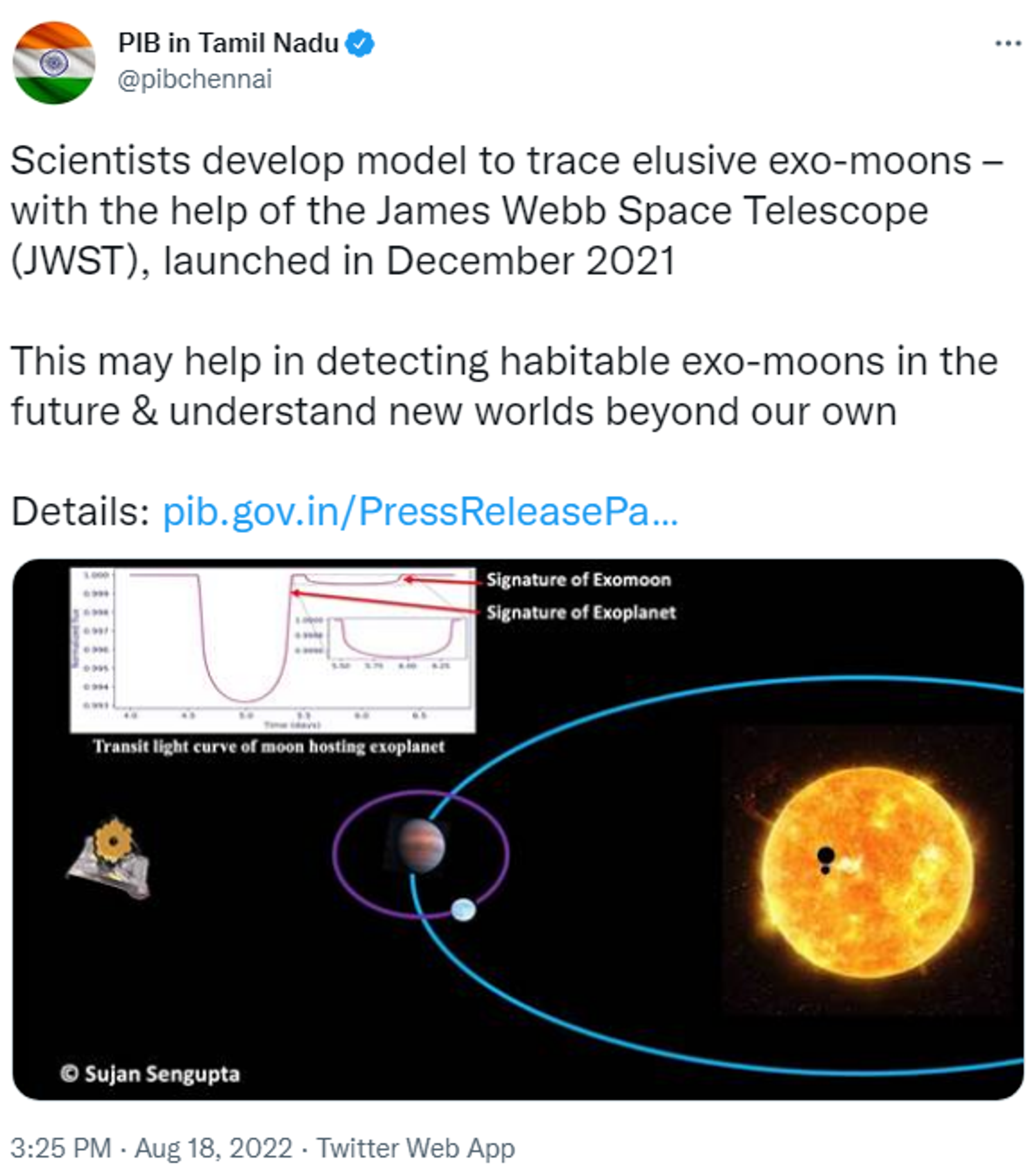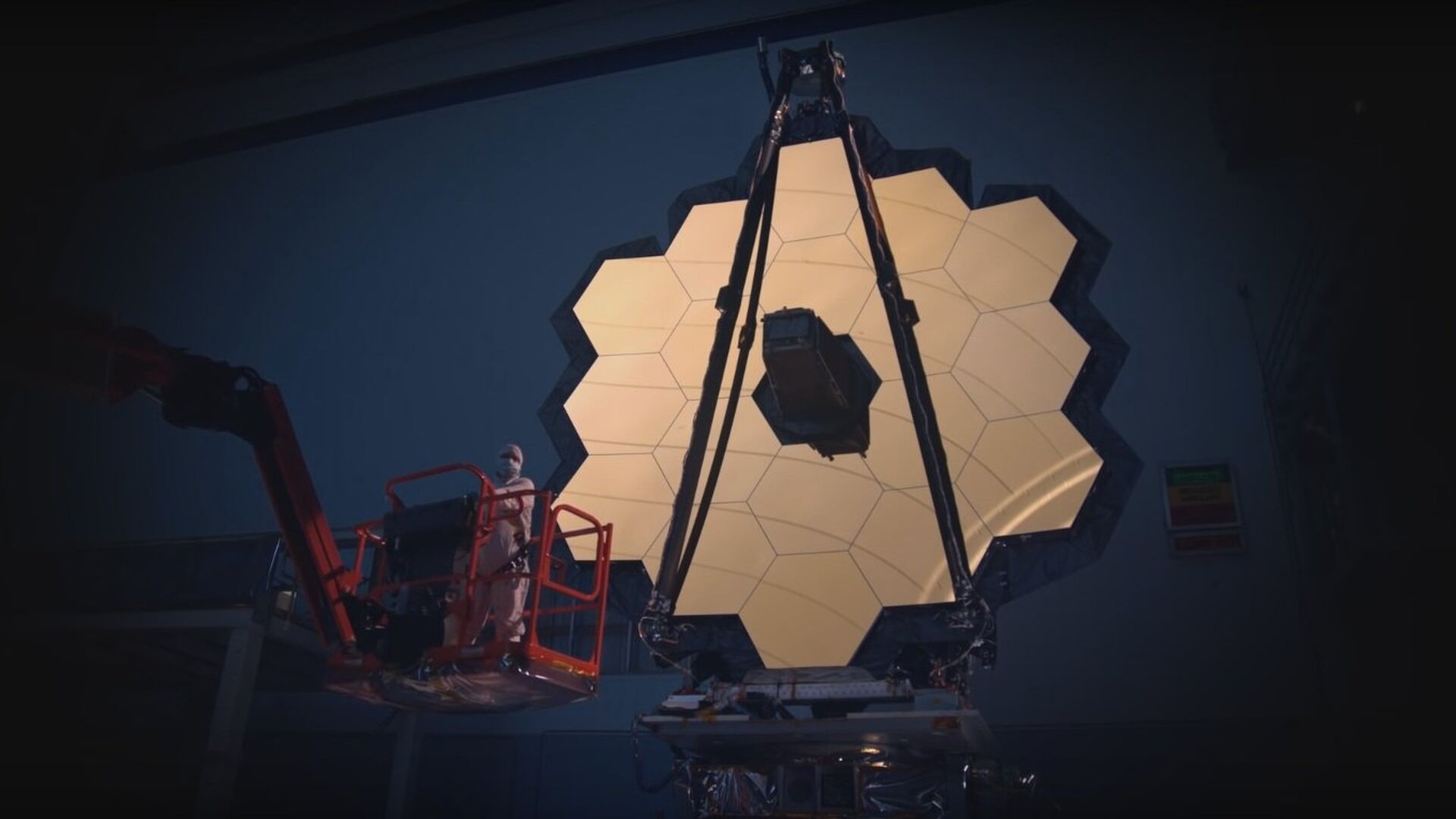https://sputnikglobe.com/20220818/indian-scientists-develop-model-to-trace-elusive-exo-moons-with-help-of-james-webb-space-telescope-1099733980.html
Indian Scientists Develop Model to Trace Elusive Exo-Moons With Help of James Webb Space Telescope
Indian Scientists Develop Model to Trace Elusive Exo-Moons With Help of James Webb Space Telescope
Sputnik International
The James Webb Space Telescope (JWST) was launched on December 25, 2021, and reached its orbit in February this year. Its infrared camera, which can see... 18.08.2022, Sputnik International
2022-08-18T14:38+0000
2022-08-18T14:38+0000
2022-10-19T20:47+0000
india
scientists
scientists
james webb space telescope
telescope
moon
planet
https://cdn1.img.sputnikglobe.com/img/104705/58/1047055874_24:0:1384:765_1920x0_80_0_0_d8bbbfa27eb352bbcb8e60d8da101b94.jpg
Scientists from the Indian Institute of Astrophysics (IIA) in Karnataka state have developed an analytical model to trace thus far elusive exo-moons ̶ natural satellites that revolve around exo-planets orbiting stars apart from the Sun.While around 5,000 exo-planets have been found through the use of various telescopes like Kepler, CoRoT, Spitzer, and Hubble, exo-moons around them have largely stayed untraceable, since they are hard to detect due to their extraordinarily small size.The new analytical model uses the radius and orbital properties of the host planet and its moon as parameters to model the photometric transit light curve of moon-hosting exo-planets.
Sputnik International
feedback@sputniknews.com
+74956456601
MIA „Rossiya Segodnya“
2022
Sangeeta Yadav
https://cdn1.img.sputnikglobe.com/img/07e4/08/1b/1080292803_0:121:960:1081_100x100_80_0_0_7490b319dab9611e309056b177265184.jpg
Sangeeta Yadav
https://cdn1.img.sputnikglobe.com/img/07e4/08/1b/1080292803_0:121:960:1081_100x100_80_0_0_7490b319dab9611e309056b177265184.jpg
News
en_EN
Sputnik International
feedback@sputniknews.com
+74956456601
MIA „Rossiya Segodnya“
Sputnik International
feedback@sputniknews.com
+74956456601
MIA „Rossiya Segodnya“
Sangeeta Yadav
https://cdn1.img.sputnikglobe.com/img/07e4/08/1b/1080292803_0:121:960:1081_100x100_80_0_0_7490b319dab9611e309056b177265184.jpg
india, scientists, scientists, james webb space telescope, telescope, moon, planet
india, scientists, scientists, james webb space telescope, telescope, moon, planet
Indian Scientists Develop Model to Trace Elusive Exo-Moons With Help of James Webb Space Telescope
14:38 GMT 18.08.2022 (Updated: 20:47 GMT 19.10.2022) The James Webb Space Telescope (JWST) was launched on December 25, 2021, and reached its orbit in February this year. Its infrared camera, which can see through cosmic dust, has captured several images of galaxies more than 100 billion light-years away.
Scientists from the Indian Institute of Astrophysics (IIA) in Karnataka state have developed an analytical model to trace thus far elusive exo-moons ̶ natural satellites that revolve around exo-planets orbiting stars apart from the Sun.
According to the press release by India's Ministry of Science & Technology, IIA’s Prof. Sujan Sengupta and his graduate student Suman Saha from the Department of Science and Technology (DST) used the data received by the James Webb Space Telescope to develop the model.
While around 5,000 exo-planets have been found through the use of various telescopes like Kepler, CoRoT, Spitzer, and Hubble, exo-moons around them have largely stayed untraceable, since they are hard to detect due to their extraordinarily small size.
The new analytical model uses the radius and orbital properties of the host planet and its moon as parameters to model the photometric transit light curve of moon-hosting exo-planets.
“The co-alignment or non-coalignment of orbits of the planet and the moon are used as parameters (using two angular parameters), and they can be used to model all the possible orbital alignments for a star-planet-moon system. Using these generic models and the analysis of photometric transit light curves of exo-planets that is being obtained by JWST, a large number of exo-moons can be detected,” DST said in its research papers.



